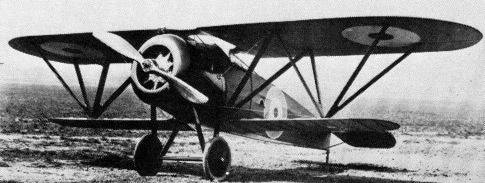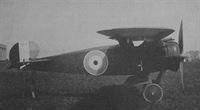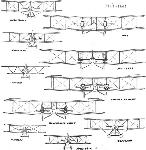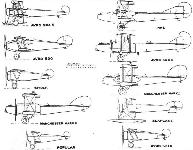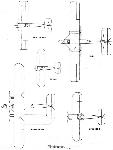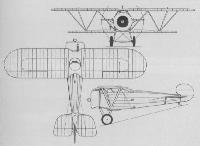A.Jackson Avro Aircraft since 1908 (Putnam)
Avro 531 Spider
First flown at Hamble in April 1918, the Spider was an unsponsored private venture single-seat fighter in which many Avro 504K components were used for speed of manufacture. To this end a shortened rear fuselage of conventional construction with spruce longerons was married to a standard Avro 504K front fuselage and the engine was a ‘borrowed’ 110 hp Le Rhone. There seems little doubt that the Avro company hoped that the Spider would replace the single-seat Avro 504K night fighter in the Home Defence Squadrons. To simplify rigging (a time consuming operation not acceptable to squadrons in the field) all flying and landing wires were replaced by very rigid welded steel Warren girder interplane bracing. This comprised six faired steel tubes arranged in three inverted triangles on each side, anchored to the main spars of the upper mainplane and to the front spar of the lower. Ailerons were fitted only to the upper wing, the lower being shorter and with a chord of only 2 ft 6 in.
The simple steel V-strut undercarriage was reminiscent of the second Avro 530 and the attempt made in the earlier design to improve substantially the pilot’s field of vision was carried a stage further in the Spider by siting the cockpit under a circular aperture in the centre section. This was mounted close to the fuselage so that the pilot’s head protruded above it. Armament consisted of a single synchronised Vickers gun on top of the fuselage and slightly to starboard of centre.
The little fighter was a delight to handle, with powerful and well harmonised controls which made it extremely manoeuvrable, and more than a match for many of its contemporaries. Performance was further enhanced by fitting a 130 hp Clerget and drawings were made for the installation of a 150 hp Bentley B.R.l rotary or a 170 hp A.B.C. Wasp I radial. Well-known pilots were invited to fly it in off duty hours and to give their opinions, for which purpose it was at the School of Special Flying, Gosport, from April 27 to May 18, 1918, and again on July 13. In this way the Spider became such a topic of conversation that the Air Ministry could not fail to take note of it. Nevertheless it was not ordered into production because the Sopwith Snipe had already been standardised as the RAF’s next single-seat fighter. The Spider was therefore used for experimental work which included benzole fuel tests at Alexandra Park in August, 1919.
A considerably modified version of the Spider was allotted type number Avro 531A. This had conventional two-bay, wire-braced mainplanes rigged with a considerable stagger and using 504K-type interplane struts. With the 130 hp Clerget rotary the Avro 531A had a performance similar to that of the Spider. While a Type 531A was reported to be under construction in early 1919, there is no means of proving that it ever existed as such and it is probable that the machine donated its fuselage, undercarriage and tail unit to the civil Avro 538, and first flew in this form.
The Avro 538 emerged from the flight shed at Alexandra Park, Manchester, in May 1919 registered K-132, a temporary civil marking later changed to G-EACR. As far as is known these letters were never carried and the machine’s main adornment was the word AVRO in the usual enormous black letters. Although powered by a 150 hp Bentley B.R.l and intended as a racer, a main spar defect limited the machine’s activities to straight and level flight, and a notice to this effect was displayed in the cockpit. Bearing fleet number 7, the Avro 538 was used solely by the Avro Transport Company’s chief engineer J. C. C. Taylor, who flew it around the joyriding sites in order to sign out the Avro 504Ks.
SPECIFICATION AND DATA
Manufacturers: A. V. Roe and Co. Ltd., Clifton Street, Miles Platting, Manchester; and Hamble Aerodrome, near Southampton, Hants.
Power Plants:
(Avro 531)
One 110 h.p. Le Rhone
One 130 h.p. Clerget
(Avro 531A) One 130 h.p. Clerget
(Avro 538) One 150 h.p. Bentley B.R.I
Dimensions, Weights and Performances:
Avro 531 Spider Avro 531A Avro 538
Clerget *Bentley Clerget Bentley
Span (upper) 28 ft. 6 in. 28 ft. 6 in. 28 ft. 0 in. 28 ft. 0 in.
Span (lower) 21 ft. 6 in. 21 ft. 6 in. 27 ft. 0 in. 28 ft. 0 in.
Length 20 ft. 6 in. 20 ft. 6 in. 20 ft. 6 in. 20 ft. 6 in.
Height 7 ft. 10 in. 7 ft. 10 in. 8 ft. 6 in. 8 ft. 6 in.
Wing area 189 sq. ft. 189 sq. ft. - 210 sq. ft.
Tare weight 963 lb. 1,148 lb. 960 lb. 975 lb.
All-up weight 1,517 lb. 1,734 1b. 1,514 1b. 1,400 1b.
Maximum speed 120 m.p.h. 124 m.p.h. 120 m.p.h. 125 m.p.h.**
Climb
to 3,500 ft. - 2 min. 12 sec. - -
to 5,000 ft. 4 min. 0 sec. - 4 min. 0 sec. 4 min. 0 sec.
to 10,000 ft. - - - 10 min. 0 sec.
Ceiling 19,000 ft. - 19,000 ft. -
Endurance/Range - 2 1/2 hours 3 hours 320 miles
*Estimated figures. **Cruising speed 108 m.p.h.
Production:
(Avro 531) One prototype only;
(Avro 538) One aircraft only, K-132/G-EACR, c/n 538/1, registered to A. V. Roe and Co. Ltd. 25.5.19, s.o.r.* 9.20
*Abbreviation used throughout to indicate 'struck off register'.
Показать полностью
P.Lewis The British Fighter since 1912 (Putnam)
A. V. Roe followed up their 530 two-seat fighter with another fighter design - the single-seat 531 Spider. The new prototype was completed by April, 1918, and turned out to be a 110 h.p. le Rhone-engined biplane of striking appearance. In the interest of quick production particular attention was paid to using readily-available 504K parts in the airframe but, despite this admirable object, the Spider was a distinctive machine. The main feature which caught the eye immediately was the system of three pairs of V struts on each side which braced the unequal-span wings without the assistance of bracing wires, the upper wings being set close to the top of the fuselage so that the pilot’s head projected through the open centre-section. A peculiar point about the Spider’s armament was the fitting of only one Vickers gun at a time when two machine-guns had become more or less standard. Tests proved the machine to be excellent for its purpose with admirable manoeuvrability, its top speed at ground level with the 130 h.p. Clerget fitted being 120 m.p.h.
Another version of the Spider was planned as the 531A, based on the 130 h.p. Clerget with different biplane wing cellules and orthodox struts and wire bracing.
Показать полностью
F.Mason The British Fighter since 1912 (Putnam)
Avro Type 531 Spider
Among the manufacturers who were prompted to produce ‘home defence’ fighters at the time of the Gotha raids on England in 1917-18 was A V Roe which designed and built the Type 531 as a privately financed project. It was hoped that this ingenious little single-seat biplane would be selected to replace the Avro 504 K ‘night fighters’ then serving with the Home Defence squadrons.
Employing numerous components of the 504 for ease and speed of manufacture, the Type 531 featured entirely new wings, the lower wing being much shorter and narrower than the upper, the two wings being interbraced by a triangulated system of six faired steel tubular struts without any flying or landing wires; this system, it was argued, would simplify the tedious and time-consuming rigging of the aircraft in the field. To afford the best possible field of vision for the pilot, the cockpit was located directly beneath a large cutout in the centre section of the very broad chord upper wing.
When first flown, the aircraft (dubbed the Spider on account of its Warren girder strut arrangement) was powered by a 110hp Le Rhone rotary engine, but this was soon replaced by a 130hp Clerget. It was flown in mock combat with contemporary in-service scouts (including the Camel and SE.5A) and proved more than a match by reason of its excellent manoeuvrability - this despite the Avro’s traditional lack of a fixed vertical tail fin. However, it was quickly pointed out that the Spider’s agility was to some extent achieved by its reversion to a single gun armament. The adoption of the single front gun had been supported by the argument that it was more desirable to possess more ammunition for a single gun than less for two, particularly for night fighting. Plans were afoot to fit 150hp Bentley B.R.1 or 170hp ABC Wasp engines, but by mid-1918 the German air attacks on England had petered out, while new aircraft - such as the Sopwith Snipe - were approaching Service entry. Two serial numbers were allotted to Spiders, but neither was taken on Service charge, and it is thought that only one example was completed.
Type: Single-engine, single-seat fighting scout biplane
Manufacturers: A V Roe & Co Ltd, Clifton Street, Miles Platting, Manchester
Powerplant: One 110hp Le Rhone 9-cylinder rotary engine; one 130hp Clerget 9-cylinder rotary engine.
Structure: Fuselage of spruce longerons and frames; twin spar wings with steel Warren girder interplane bracing. All fabric-covered.
Dimensions: Span, 28ft 6in; length, 20ft 6in; height, 7ft 10in; wing area, 189 sq ft.
Weights (Clerget): Empty, 1,148lb; loaded, 1,734lb.
Performance (Clerget): Max speed, 120 mph at sea level; climb to 5,000ft, 4.0 min; service ceiling, 19,000ft.
Armament: One fixed synchronized 0.303in Vickers machine gun with 800 rounds.
Prototype: One (probably B3952, first flown in April 1918). No production.
Показать полностью
W.Green, G.Swanborough The Complete Book of Fighters
AVRO 531 SPIDER UK
An unsponsored private-venture single-seat fighter designed by Roy Chadwick and flown for the first time in April 1918, the Spider made use of a number of Avro 504 components and had a fabric-covered wooden structure with a system of Warren-girder steel-tube interplane struts. The upper wing was mounted close to the fuselage and directly above the cockpit. In its original form, the Spider was powered by a 110 hp Le Rhone 9J nine-cylinder rotary engine, and proved to possess exceptional manoeuvrability, but overall performance was not sufficiently in advance of the contemporary Sopwith Camel to warrant quantity production. Armament comprised one fixed synchronised 0.303-in (7,7- mm) Vickers machine gun, and a 130 hp Clerget 9B rotary was later fitted, the following details relating to the Spider fitted with this power plant.
Max speed, 120 mph (193 km/h) at sea level, 110 mph (177 km/h) at 10,0 ft (3 050 m).
Time to 10,000 ft (3 050 m), 9.5 min.
Empty weight, 963 lb (437 kg).
Loaded weight, 1,517 lb (688 kg).
Span, 28 ft 6 in (8,68m).
Length, 20 ft 6 in (6,25 m).
Height, 7 ft 10 in (2,38 m).
Wing area, 189 sqft (17,55 m2).
Показать полностью
J.Bruce British Aeroplanes 1914-1918 (Putnam)
Avro 531, the Spider
THE Avro Spider appeared in April, 1918. It was a compact little single-seat fighter in which numbers of Avro 504K components were used in order to ensure rapid and easy production. In fact, the complete front portion of the fuselage was identical to that of the 504K, and many of the small fittings were standard 504K components.
The wing bracing was quite unlike anything used on any other contemporary British aeroplane. There were neither flying nor landing wires, but the structure was braced by a triangulated system of faired steel tubes. The lower wing was shorter than the upper, and was of unusually narrow chord: in this respect the wing arrangement resembled that of the Nieuport Scouts, and the lower wing seemed to be little more than part of the bracing for the upper mainplane. Spars were built-up spruce components, and the fuselage longerons and spacers were also spruce; the petrol tank was situated behind the cockpit. The undercarriage was a simple vee structure of faired steel tubes.
Particular attention had been paid to achieving the best possible view for the pilot. To this end the upper wing was mounted very close to the fuselage, and a circular hole was cut in the centre-section: through this hole the pilot’s head protruded. The mainplane was level with his eyes, so that his view of the upper hemisphere could not have been better; and the forward and downward view was helped by the short nose and narrow lower wing.
The Spider’s manoeuvrability was exemplary. During its trials it repeatedly outmanoeuvred contemporary standard scouts against which it was matched in mock combat. The Spider did not go into production, however, doubtless because of existing production programmes and the promise of other new types. It is also doubtful whether the fighter pilots of the Spider’s day would have welcomed a reversion to only one machine-gun as their armament.
As originally built, the Spider was powered by a 110 h.p. Le Rhone rotary engine, but it seems fairly certain (as the quoted performance figures show) that a 130 h.p. Clerget was also fitted. It would have been a simple matter to make such an engine-change, in view of the use of the 504K front fuselage. According to Jane's All the World's Aircraft, 1919 edition, it was intended to fit later Spiders with the Bentley B.R.2 engine, but the estimated performance figures quoted for that engine were apparently based on a power output of 180 h.p. whereas the B.R.2 delivered 238 h.p.
Another version of the design was given the Avro type number 531A, but it is uncertain whether the machine was ever completed. This variant was designed with normal biplane wings which had conventional interplane struts and wire bracing. The upper centre section was left completely open, as on the Sopwith Dolphin, but in the Avro 531A the pilot sat behind the rear spar instead of between the spars.
SPECIFICATION
Manufacturers: A. V. Roe & Co., Ltd., Clifton Street, Miles Platting, Manchester, and at Hamble.
Power: 110 h.p. Le Rhone; 130 h.p. Clerget.
Dimensions: Span: upper 28 ft 6 in., lower 21 ft 6 in. Length: 20 ft 6 in. Height: 7 ft 10 in. Chord: upper 6 ft, lower 2 ft 6in. Gap: 4 ft 2 1/2 in. Stagger: 2 ft. Dihedral: nil. Incidence: nil. Span of tail: 8 ft 6 in. Chord of tailplane: 2 ft 8 in. Chord of elevators: 1 ft 6 in. Tyres: 700 X 78 mm.
Areas: Wings: upper 144 sq ft, lower 45 sq ft, total 189 sq ft. Ailerons: each 11 sq ft, total 22 sq ft. Tailplane: 17-5 sq ft. Elevators: 11 sq ft. Rudder: 7-8 sq ft.
Weights (lb) and Performance:
130 h.p. Clerget Estimated figures for Bentley B.R.2
Weight empty 963 1,148
Military load 125 158
Pilot 180 180
Fuel and oil 249 248
Weight loaded 1,517 1,734
Maximum speed (m.p.h.)
at ground level 120 124
8,000 ft - 121
10,000 ft I 10 122
15,000 ft - i<5
m. s. m. s.
Climb to
3,500 ft - - 2 12
5,000 ft 4 00 - -
8,000 ft - - 5 00
10,000 ft 9 30 7 00
15,000 ft 22 00 13 30
18,000 ft - - 20 00
20,000 ft - - 26 00
Ceiling (feet) 19,000 -
Endurance at
10,000 ft (hours) - 2
15,000 ft (hours) - 2 1/2
Tankage: Petrol: 26 1/2 gallons. Oil: 6 gallons.
Armament: One fixed Vickers machine-gun mounted on top of cowling to starboard of centre, synchronised to fire forward through the revolving airscrew; 800 rounds of ammunition were carried.
SPECIFICATION OF AVRO 521A
Power: 130 h.p. Clerget.
Dimensions: Span: upper 28 ft, lower 27 ft. Length: 20 ft 6 in. Chord: 4 ft 6 in. Gap: 4 ft 3in. Stagger Dihedral: 2. Incidence: 1 30'.
Areas: Wings: upper 106 sq ft, lower 104 sq ft, total 210 sq ft. Ailerons: each 7-3 sq ft, total 29-2 sq ft. Tailplane: 17.5 sq ft. Elevators: 11 sq ft. Rudder: 7-8 sq ft.
Weights: Empty: 960 lb. Loaded: 1,514 lb.
Performance: Maximum speed at ground level: 120 m.p.h.; at 10,000 ft: 110-5 m.p.h.; at 15,000 ft: 103 m.p.h. Climb to 5,000 ft: 4 min; to 10,000 ft: 9 min 30 sec; to 15,000 ft: 22 min. Ceiling: 19,000 ft. Endurance: 3 hours.
Serial Numbers: It is believed that the serial numbers B.3952-B.3953 were allotted for Avro Spiders.
Показать полностью
H.King Armament of British Aircraft (Putnam)
Spider. Although a contemporary drawing shows two Vickers guns on this 1918 'wireless scout' (the 'wireless' signifying rigid wing bracing) only one gun was actually fitted, though this had more than the normal amount of ammunition. The gun was mounted slightly to starboard of the centre line and was largely internal. One contemporary specification listed these items: 'gun, 70 lb; mounting and ammunition box, 20 lb; belt and 800 rounds, 60 lb; Very pistol with cartridges, 8 lb.# Like the later single-gun Hawker Hornbill, the Spider carried more than the usual quantity of ammunition for a Vickers gun.
Показать полностью
Jane's All The World Aircraft 1919
An unsponsored private-venture single-seat fighter designed by Roy Chadwick and flown for the first time in April 1918, the Spider made use of a number of Avro 504 components and had a fabric-covered wooden structure with a system of Warren-girder steel-tube interplane struts. The upper wing was mounted close to the fuselage and directly above the cockpit. In its original form, the Spider was powered by a 110 hp Le Rhone 9J nine-cylinder rotary engine, and proved to possess exceptional manoeuvrability, but overall performance was not sufficiently in advance of the contemporary Sopwith Camel to warrant quantity production. Armament comprised one fixed synchronised 0-303-in (7,7-mm) Vickers machine gun, and a 130 hp Clerget 9B rotary was later fitted, and the following details relate to the Spider fitted with this power plant.
Max speed 120 mph (193 km/h) at sea level
110 mph (177 km/h) at 10,000 ft (3 048 m).
Time
to 10,000 ft (3 048 m) 9.5 min.
Empty weight 963 lb (473 kg).
Loaded weight 1,517 lb (688 kg).
Span 28 ft 6 in (8,68 m).
Length 20 ft 6 in (6,25 m).
Height 7 ft 10 in (2,38 m).
Wing area 189 sq ft (17,55 m2).
Показать полностью
A.Jackson British Civil Aircraft since 1919 vol.1 (Putnam)
AVRO 538
Single-seater powered by one 150-h.p. Bentley B.R.1, constructed from Avro 504K components by A. V. Roe and Co. Ltd., Manchester 1919. One aircraft only: K-132/G-EACR, c/n 538/1. Used as communications aircraft by J. C. C. Taylor, ground engineer i/c the Avro Transport Company’s nation-wide fleet of joy-riding Avro 504Ks. Scrapped 9.20. Span, 28 ft. Length, 20 ft. 6 in. Tare wt., 975 lb. A.U.W., 1,400 lb. Max. speed, 125 m.p.h. Cruise, 108 m.p.h.
Показать полностью
Журнал Flight
Flight, March 20, 1919.
"MILESTONES"
The Avro Machines
The Avro "Spider," Type 531. April, 1918.
The following spring saw an entirely different type of machine issue from the Avro works. This was a single-seater "Scout," in which the wing bracing was along quite unusual lines. From the illustrations it will be seen that, instead of the ordinary wing bracing wires or cables, the "Spider," as this machine was called, had Vee struts arranged in the form of a Warren truss. It may be remembered that in 1917 we published in FLIGHT a series of articles by "Marco Polo," entitled "Wing Bracing and Head Resistance," in which this particular form of wing bracing was dealt with. In this article the author expressed the opinion that although the combination of Nieuport Vee struts and Warren truss did not appear to give the absolute minimum of resistance, it did have a low resistance, while at the same time having the structural advantage that the distance between supports was reduced, thus resulting in a lighter structure, and that therefore the arrangement might be found to be worth trying.
This appears to be what the Avro designer has done, and we may therefore be pardoned a certain special interest in this particular machine. We understand that the "Spider" was extremely manreuvrable and light on the controls, and the accompanying table of performance indicates that the machine had quite a good turn of speed - 120 m.p.h. at ground level with a 130-h.p. Clerget engine is not bad - while the climb was also satisfactory. The pilot was so placed that his eyes were on a level with the top plane, in which a circular opening was cut out. This gave a good view both upwards and horizontally in all directions, while the small chord of the bottom plane gave a minimum of obstruction to downward visibility. The "Spider" might conceivably make a good sporting model, especially if fitted with a somewhat smaller engine, since the petrol bill for a motor of 130 h.p. would probably be more than the majority of owners would care to spend. However, as the machine is light there does not appear to be any reason why, in a slightly modified form, it should not be fitted with, say, an engine of 80 h.p. or thereabouts.
The Fighting Scout, type 531 A.
This machine is of the ultra-modern scout type, with two pairs of inter-plane struts on each side, and with the centre section struts slightly raked outwards. The centre section in the top plane has been left open, in the manner of the Sopwith Dolphin, and the pilot is so placed that his head is in the rear portion of, and slightly below, this opening, so that his view is interrupted to a small extent only. Generally speaking, the machine follows usual Avro practice, in the shape of its body and other main components, such as the semicircular balanced rudder etc. The figures relating to its performance are estimated, and are practically identical with those relating to the "Spider," which has, it will be remembered, the same engine power - a 130 h.p. Clerget. As the total wing area is practically the same in both these machines - differing only in the disposition of the area of top and bottom planes respectively - this affords an interesting comparison between the standard type of machine with two pairs of struts on each side and the Warren-cum-Nieuport type of bracing, accompanied, of course, by a large area top plane and a small area bottom plane. According to the figures given there is little to choose between the two forms, but the "Spider" type may be thought to give the better visibility of the two.
It may be pointed out that the figures of performance given in the table are estimated, the machine not having been flown at the time of writing this article. It is, however due to be tested almost any day now, and we hope shortly to be able to publish a photograph of it.
Показать полностью
